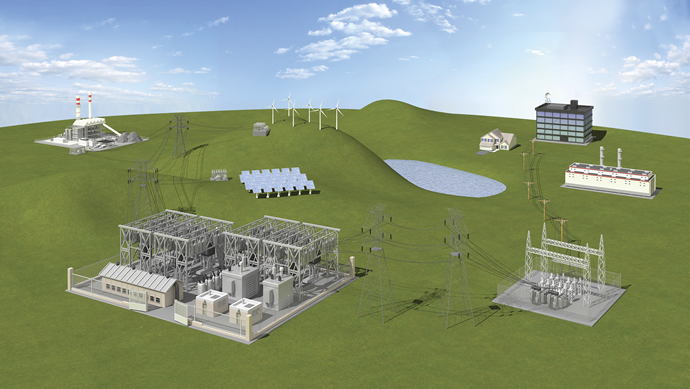Top tips for implementing wireless technology in the smart grid
Germán Fernández, Global Vertical Marketing Manager for Power Transmission and Distribution at Belden highlights the key factors to be considered when working with a smart, modern grid.
The seeds of the current smart grid were planted in the early 1980s with the introduction of electronic control, monitoring and metering. Originally a centralised, unidirectional system, the technological developments of the 1990s - digital control systems, graphic interfaces and software - changed the standard of the electric grid. Now, the thousands of highly interconnected, distributed generation sources and bi-directional networks possible within the electric grid have greatly increased the complexity of the electricity distribution process.
The distributed nature of the grid boosts efficiency and reliability, and establishes load balances between different generation plants, consumers and countries. However, with this added complexity, power engineers need real time, bi-directional communication in order to support a modern power grid and employ reliable communications.

Above: the complexity of the electricity distribution process has increased significantly
Wireless technologies are the most suitable method for deploying communications in densely populated areas with high amounts of distribution lines. Here are a few things to consider in order to successfully implement wireless in smart grid applications:
- Bandwidth: Each device needs to remain stable to allow for services planning. To do so, the bandwidth needs to be consistent for all devices.
- Latency: It’s important to know about any communication delays, however time critical applications in smart grids run on fibre, so latency shouldn’t be a big challenge.
- Security: Networks should deter and monitor unauthorised access, misuse and modification, or denial of access, to both data and physical smart grid assets. Prevention mechanisms include incorporating multiple, threat specific layers of defence onto the network, based on the behaviour and context of each potential threat.
- Reliability: The network should function reliably under stated conditions for a specified period of time, specific moment or time interval.
The monitoring, analysis and control capabilities that come with a modernised smart grid improve the reliability, economics and overall sustainability of the production and distribution of electricity. However, with the complexity and interconnectedness of the grid, advanced communications are essential for enabling modern applications, such as grid visualisation, real time load monitoring, automated demand response, advanced protection, asset monitoring, smart metering and consumer load control.
Top tips
To ensure network integrity while working wirelessly in smart grid applications, follow these three tips:
Tip 1 - Use cellular communications for secure data transfer: The high speed data access that comes with cellular communication offers a new way to reach local assets in remote utility facilities and third party installations. The technology transfers data in a secure and reliable way - even through public networks - to utility substations, energy generation locations, utility offices and secondary transformation centres. Using cellular over public networks combines the benefits of high penetration frequencies with the already available backbone from the telecom utility’s internet connection.
This 4G technology is well suited for smart grids, as it allows for two-way communication, remote monitoring and control of the grid; quick and easy installation; and broadband speeds. With 4G you can remotely locate, isolate and restore power outages, thereby increasing the stability of the grid. You can also introduce other valuable services, such as condition monitoring and new features like video surveillance.
Tip 2 - Understand the implications of your unique operational environment: When working in smart grid applications, it’s always important to consider how the operating environment will affect the network. Wireless technology can grant enhanced network access, mobility and interoperability, but in order to do so, the data networks need to operate reliably in harsh environments and withstand high electromagnetic interfaces (EMI), large temperature variations, shocks, vibrations and dust.
Understanding the nuances of your unique operating environment ahead of time, and knowing which specialised features you will need for successful implementation, are critical for ensuring network integrity and reliability.
Tip 3 - Choose a complete solution to meet your particular needs: Engineers need a complete, robust solution in order to successfully keep wireless network communications up and running. From the cables, connectors, patch cords and patch panels, to a broad portfolio of wireline and wireless switches for harsh environments, teams should have immediate access to all the network components they need to do their job. When choosing the right solution, look for these key things:
- Compact Ethernet port Long Term Evolution (LTE) router for unlimited network connectivity.
- Integrated firewall for maximum network perimeter protection.
- Dual SIM card for network redundancy to ensure connectivity availability to a back-up network in case of primary network failure.
- Global Positioning System (GPS) for geospatial localisation to help maintenance teams to easily locate a fault in the communications network and restore service to increase network availability.
With smart grid communication networks becoming more sophisticated and data rates increasing to support new applications, special performance features are required to ensure a high degree of network resilience. For smart grid engineers to maintain a steady flow of electricity throughout the grid, they need to ensure their networks stay up and running, and limit down-time. Implementing a complete wireless technology solution designed for smart grid applications is the best way to ensure this network availability.










